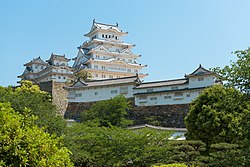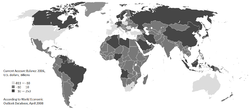 | |
| Currency | Japanese yen (JPY, ¥) |
|---|---|
| 1 April – 31 March | |
Trade organisations | APEC, WTO, CPTPP, RCEP, OECD, G-20, G7 and others |
Country group | |
| Statistics | |
| Population | |
| GDP | |
| GDP rank | |
GDP growth | |
GDP per capita | |
GDP per capita rank | |
GDP by sector |
|
GDP by component |
|
| 3.1%[ when? ] | |
| 33.8 medium (2021) [7] | |
| |
Labour force | |
Labour force by occupation |
|
| Unemployment | |
Average gross salary | ¥452,247 / US$3,106 monthly [14] [15] (2024) |
| ¥352,541 / US$2,421 monthly [16] [17] (2024) | |
Main industries | |
| External | |
| Exports | |
Export goods |
|
Main export partners |
|
| Imports | |
Import goods |
|
Main import partners |
|
FDI stock | |
Gross external debt | (103.2% of GDP) |
| Public finances | |
| |
| 1.35% of GDP (2022 est.) [21] | |
| Revenues | ¥196,214 billion [21] 35.5% of GDP (2022) [21] |
| Expenses | ¥239,694 billion [21] 43.4% of GDP (2022) [21] |
| Economic aid | donor: ODA, $10.37 billion (2016) [24] |
All values, unless otherwise stated, are in US dollars. | |
Japan has a highly developed mixed economy, often referred to as an East Asian model. [27] According to the IMF forecast for 2025, it will be the fourth-largest economy in the world by nominal GDP and the fifth-largest by purchasing power parity (PPP) by the end of the year. [28] It constituted 3.7% of the world's economy on a nominal basis in 2024. According to the same forecast, the country's nominal per capita GDP (PPP) will be $56,440 (2025). [29] [30] Due to a volatile currency exchange rate, Japan's nominal GDP as measured in American dollars fluctuates sharply.
Contents
- History
- Edo period (1603–1868)
- Pre-war period (1868–1945)
- Post-war period (1945–1989)
- Heisei period (1989–2019)
- Reiwa period (2020–present)
- 2020–21 recession
- Post-recession (2021–present)
- Macro-economic trend
- GDP composition
- Development of main indicators
- Sectors of the economy
- Agriculture
- Industry
- Services
- Infrastructure
- Finance and banking
- Trade
- Labor force
- Law and government
- Culture
- Overview
- Keiretsu
- Other economic indicators
- See also
- Notes
- External links
A founding member of the G7 and an early member of the OECD, Japan was the first country in Asia to achieve developed country status. In 2024, Japan was the sixth-largest in the world as an importer and eight-largest as an exporter. [31] [32] The country also has the world's fourth-largest consumer market. [33] Japan used to run a considerable trade surplus, but the decline of the manufacturing sector since the 1980s and increased fossil fuel imports after the Fukushima nuclear accident in 2011 have changed this trend in recent years. [34] [35] Being the world's largest creditor nation, [36] [37] [38] Japan has a considerable net international investment surplus. The country has the world's second-largest foreign-exchange reserves, worth $1.4 trillion. [39] Japan has the third-largest financial assets in the world, valued at $12 trillion, or 8.6% of the global GDP total as of 2020. [40] [41] Japan has a highly efficient and strong social security system, which comprises roughly 23.5% of GDP. [4] [42] [3] The Tokyo Stock Exchange is the world's fourth-largest stock exchange by market capitalisation as of 2025. [43] [44]
Japan has a highly service-dominated economy, which contributes approximately 70% of GDP, with most of the remainder coming from the industrial sector. [45] The country's automobile industry, which is the third largest in the world, dominates the industrial sector, with Toyota being the world’s largest manufacturer of cars. [46] In 2022, Japan spent around 3.7% of GDP on research and development. As of 2025, 38 of the Fortune Global 500 companies are based in Japan. [47]
Long having been an agricultural country, it has been estimated that Japan’s economy was among the top ten in the world by size before the industrial revolution started. [48] Industrialisation in Japan began in the second half of the 19th century with the Meiji Restoration, initially focusing on the textile industry and later on heavy industries. The country rapidly built its colonial empire and the third most powerful navy in the world. After the defeat in the Second World War, Japan’s economy recovered and developed further rapidly, primarily propelled by its lucrative manufacturing exporting industries. [49] It became the second largest economy in the world in 1988 and remained so until 2010, [50] and on a nominal per capita basis, the most high-income among the G7 countries in the 1980s and 1990s. [51] In 1995, Japan’s share of the world’s nominal GDP was 17.8%, reaching approximately 71% of that of the United States. [50]
Driven by speculative investments and excessive lending, the Japanese asset price bubble of the early 1990s burst, triggering a prolonged period of economic stagnation marked by deflation and persistently low or negative growth, now known as the Lost Decades. From 1995 to 2023, the country’s GDP fell from $5.5 trillion to $4.2 trillion in nominal terms. [52] At the turn of the 21st century, the Bank of Japan set out to encourage growth through a policy of quantitative easing, with the central bank purchasing government bonds at an unprecedented scale to address the persisting deflationary pressure. [53] [54] In 2016, the Bank of Japan introduced a negative interest policy to stimulate economic growth and combat persistent deflationary pressure. A combination of domestic policies and global economic conditions helped the country achieve its 2% inflation target, leading to the conclusion of the policy in 2024. [55] [56]
As of 2021, Japan has significantly higher public debt than other developed nations, at approximately 260% of GDP. [57] [58] 45% of this debt is held by the Bank of Japan, and most of the remainder is also held domestically. [57] The Japanese economy faces considerable challenges posed by an ageing and declining population, which peaked at 128.5 million people in 2010 and has fallen to 122.6 million people in 2024. [59] In 2024, the country's working age population consisted of approximately 59.6% of the total population, which was the lowest rate among all the OECD countries. [60] According to 2023 government projections, the country's population will fall to 87 million by 2070, with only 45 million of working age. [61]
















